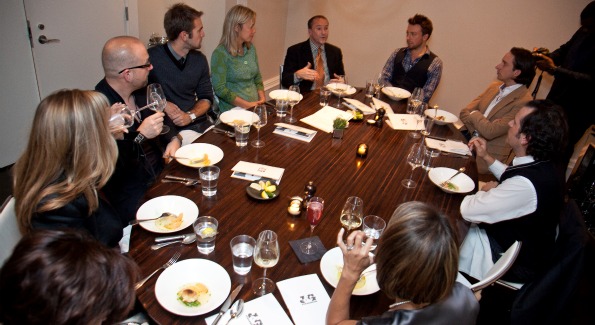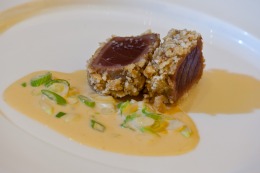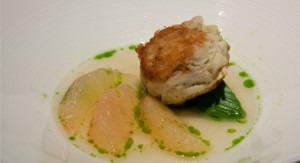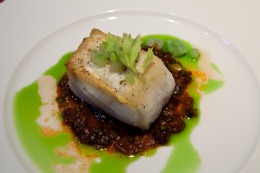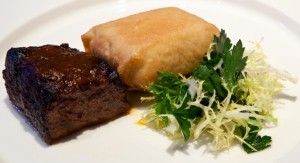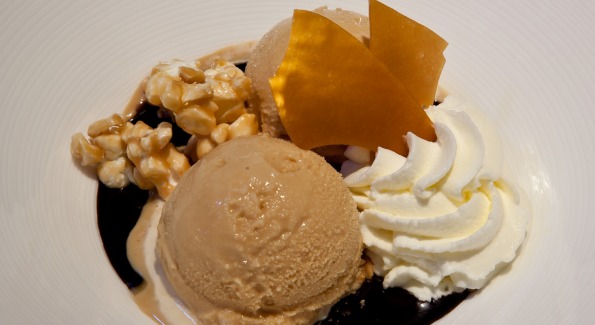Some of Washington’s leading creative movers and shakers recently gathered at J&G Steakhouse to discuss the area’s growing creative scene.
Washington Life Executive Editor Michael Clements moderated the discussion, which was organized around the private exclusive private six-course meal, prepared by Michelin-rated chef Jean-Georges Vongerichten. Each course corresponded to a particular creative area: TV, film, theater, arts, architecture, style, fashion and performing arts. Read on to find out where D.C. is headed, creatively.
[vimeo]http://vimeo.com/16468137[/vimeo]
The Creatives
Michael M. Clements, event moderator, executive editor of Washington Life. Gloria Nauden, executive director, D.C. Commission on the Arts and Humanities. Philippa Hughes chief creative contrarian, Pink Line Project. Darren Thomas, development director, Washington Preforming Arts Society. James Cornwell, art director, PR at Partners and co-founder Fashion BS. Derrick Lachney, colorist, One80 Salon. Kathy Hollinger, director, Washington D.C. Office of Motion Picture and Television Development (MPTD). Drew Porterfield, curator and director, Long View Gallery. Christy Schlesinger, architect, Schlesinger architects. Matthew Gardener, resident director, Signature Theatre.
Course 1: Architecture
Pairing: Rice Cracker Crusted Tuna with Citrus-Chili Sauce
Michael Clements: How has architecture in the city changed?
Christy Schlesinger: I think the restaurant business has really introduced modern architecture to D.C. and made the city become more accepting of it. The restaurant designs have gotten more and more modern, bringing a New York flair. It’s drawn a number of talented architects to the area, who have in turn created more modern spaces.
Matthew Gardiner: I’ve seen a lot more buildings that are expanding what we consider as D.C.
Schlesinger: Our firm worked on Water Street, which from the outside is very conservative but from the inside it’s very modern. That aesthetic is selling, but since the crash it’s more about being hip. Modern is too expensive. In order to do a really crisp modern space, it has to be incredibly minimal, but minimal is very expensive. It’s very unforgiving because it doesn’t have trim work and all the things that can hide problems in construction. Everything has to be a certain a way, the lighting has to be a certain way because you see it more clearly. Basically, the simpler it is, probably the more expensive it is to build. So currently in a restaurant design we’re seeing a move towards hip, mainly because of economics.
Course 2: Theater
Pairing: Butternut Squash Soup with Fall Mushrooms
 MC: How can we improve local theatre?
MC: How can we improve local theatre?
Matthew Gardiner: We need to change both how we as a theatre community view ourselves as well as those outside our community view us. The opinion tends to be that our city is all about politics that doesn’t look at creative people as seriously as those in politics.
Darren Thomas: It’s all about commercial, if you’re not a commercial success then no one is willing to notice you. Look how much press “Mary Poppins” got. But, theatres like Woolly Mammoth are taking chances.
Matthew Gardiner: Look at what Signature is doing now, not to say that there isn’t validity to “Chess” and “Sunset Boulevard,” but there are decisions we’ve made recently because of the economy. But going back to your question about taking it to the next level, I think the new Arena Stage Theatre will help. It’s huge for theater in D.C. It’s about coming to see theater, but it’s also about coming to a beautiful space.
Darren Thomas: Like The Kennedy Center.
Course 3: Funding and Development
Pairing: Crab Cake with Pink Grapefruit, Avocado and Ginger
MC: Darren, what about fund-raising and the arts and how to get that dollar?
Darren Thomas: The cost of doing business in D.C. is very expensive. Anytime we bring an orchestra, we could sell out the entire concert hall and we will still lose $50,000. So that’s where the underwriter comes in. If we don’t have someone doing $50,000 to $100,000, we’re seeing some serious problems. But the Washington Performing Arts center is one of the few organizations that are still operating in the black. Our donations were up 10 percent; we haven’t really seen a real decline. Where we saw the decline was from the city. When an group or artist comes to us, we try to choose a venue that artists can fit into so that we can sell it. You start them off at the 600-seat venue and if it does well then you move them to an 850-seat. And finally you start to look at the Kennedy Center, because the expense of going from one of those venues to the Kennedy Center is astronomical.
Course 4: Film
Pairing: Seared Halibut with Scallion-Chili Sauce, Basil and Celery
MC: Kathy, what’s your mission at MPTD?
Kathy Hollinger: The film commission is working hard to bring business into the district. The challenge is that cities and states usually have incentives, they have dollars to bring in large scale productions. We don’t have that in Washington. We have a great package, but there is no funding aspect. We’re working on turning that around. The other thing the studios complain about was that there isn’t a single point where they can coordinate longer location shoots. We’re streamlining the process so red tape and permit procedures don’t scare productions away.
Michael Clements: What about local talent and production teams?
Kathy Hollinger: We put a package together that lets studios know that we have the resources for prolonged film production in the city. We have lists of caterers, grips, driver and equipment rentals, but casting is still an issue. We need more than Central Casting. We’re working hard to brand Washington as a full service film destination, not just for nice monument shots. We have a lot of ”non-political” locations as well as crews, talent, and support.
Course 5: Visual Arts
Pairing: Tangy Glazed Short Ribs with Crunchy Cheddar Grits and an Herb Salad
MC: Why has Long View captured so much energy and attention in the D.C. visual arts scene?
Drew Porterfield: The growth has been amazing. When Long View Gallery opened three years ago. We were in a tiny 800 square-foot gallery space. We were definitely a small fish. We found a developer that believed in us. That’s not easy in this town. We moved into our new space. We focused on local artists like Scott Brooks. And it occurred at a time when the city’s population was becoming more art savvy. We went from a staff of one to a staff of six and created some jobs.
Phillipa Hughes: We need to develop a more culturally curious audience who will become consumers who will foster the local artists. We have to give people more accessible points of entry. You can’t just say “go to the Kennedy Center.” It’s too intimidating. This can actually keep people from enjoying the art scene.
Course 6: Style & Fashion
Pairing: Salted Caramel Ice Cream Sundae with Peanuts, Popcorn and Chocolate Sauce
MC: Will Washington ever shake its unstylish image?
James Cornwell: I’ve seen a huge movement in the fashion of D.C. We’re influenced, politically, by the world: London, Paris, New York, everywhere. But now fashion is starting to be influenced by those cities; especially the charity events. It’s become huge. Even walking in here tonight, I have to tell you that I have Le Deux denim on. They have buttons and everything all over the back, they’re ripped in front and have safety pins on them and I thought, maybe I shouldn’t be wearing this in Washington.
Christy Schlesinger: I wore shoulder pads just for you.
James Cornwell: Thank you darling.
Derrick Lachney: It’s different with hair, in a way, it’s the only place women can be very adventurous. They might dress more conservative, but they can get a little daring on the hair. I’m continually surprised at the risks some women are taking in D.C.
James Cornwell: It’s still transitional. More designers are coming to town. I have hope.

